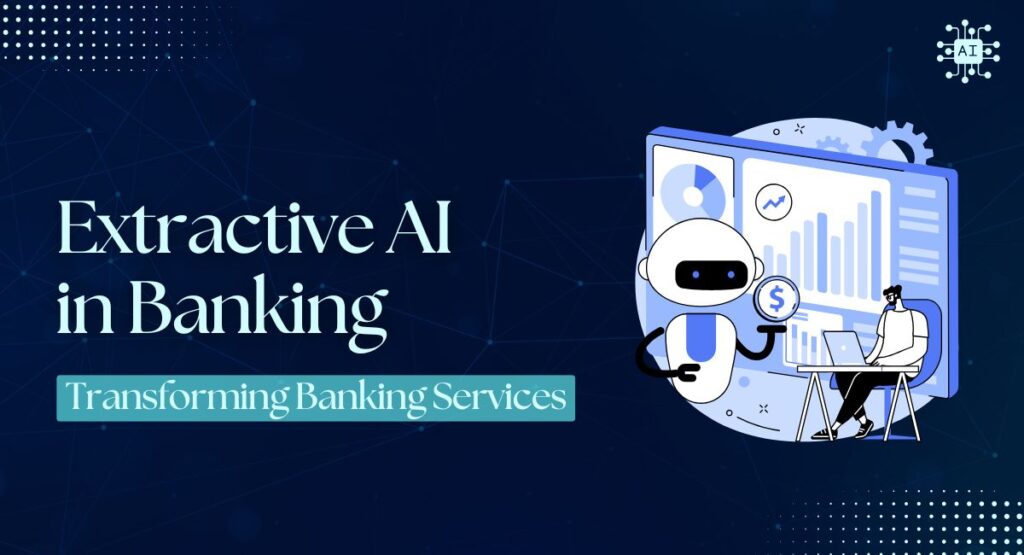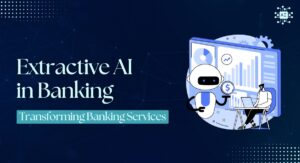Banks handle a huge amount of data every day—everything from customer applications to financial transactions. Traditionally, managing this data required a lot of manual work, which is slow and prone to errors. This can lead to costly mistakes, inefficiencies, and even compliance issues.
The challenge for banks is figuring out how to process all this data quickly and accurately. This is where extractive AI comes in. Extractive AI automatically pulls relevant information from large documents and data sources, speeding up processes and reducing errors. It helps banks handle tasks like loan approvals, fraud detection, and regulatory compliance with greater efficiency.
In short, banks face the problem of data overload, and extractive AI provides the solution by automating and streamlining their operations.
What is Extractive AI?
Extractive AI is a type of artificial intelligence that specializes in extracting specific, relevant information from large datasets, especially unstructured sources like documents, emails, and reports.
Unlike traditional AI systems that generate new content, extractive AI focuses on identifying and retrieving useful data hidden within text-heavy documents.
This makes it highly valuable in industries like banking, where financial institutions deal with vast amounts of paperwork and digital data daily.
Banks can use extractive AI to quickly pull key details from loan applications, compliance documents, and transaction records, automating tasks that were once manual and time-consuming.
Key Applications of Extractive AI in Banking
Here are key Application reshaping banking operations by automating critical processes and improving data-driven decision-making.
- Manual data processing: Time-consuming and prone to human errors.
Examples: A bank’s loan department can use extractive AI to automatically pull income and credit details from loan applications, drastically reducing review time.
- Data overload: Vast amounts of unstructured data that are hard to manage.
Examples: A compliance team can use AI to scan through thousands of regulatory documents and extract key sections that require immediate attention.
- Compliance risks: Potential errors in regulatory reporting due to manual reviews.
Examples: Banks like JPMorgan Chase use AI to ensure that their documents meet regulatory requirements by identifying critical data points that must be reported, minimizing compliance-related errors.
- Operational inefficiencies: Slower decision-making and increased costs from manual work.
Examples: AI chatbots can provide customers with fast answers by pulling relevant information from customer databases, reducing wait times and improving service quality.
- Fraud detection delays: Slower identification of suspicious activities due to manual processes.
Examples: Extractive AI can monitor real-time transaction patterns, flagging unusual activities immediately, which helps banks prevent fraud more effectively.
Benefits of Extractive AI for Banks
The adoption of extractive AI offers banks a multitude of benefits, ranging from operational efficiency to customer satisfaction. Below are some of the key advantages:
- Improved Efficiency: Automating data extraction reduces manual workloads, allowing banks to process documents and analyze data faster. This translates into cost savings and higher productivity.
- Better Accuracy: AI-driven processes are less prone to human error. Whether it’s extracting data from loan applications or scanning for compliance issues, extractive AI ensures accuracy and consistency.
- Cost Savings: By automating tasks that once required human oversight, banks can reduce labor costs and allocate resources to more strategic activities. This leads to significant savings, especially in high-volume data processing tasks like document review.
- Enhanced Decision-Making: Extractive AI allows banks to analyze data in real time, leading to faster, more informed decisions. Whether it’s approving a loan or flagging suspicious activity, AI ensures timely and effective responses.
- Improved Customer Experience: Customers benefit from faster service, more personalized recommendations, and quicker issue resolution. AI-powered chatbots can handle common queries instantly, enhancing overall satisfaction.
The Growing Importance of AI in Banking
Here are Growing Importance of AI in Banking:
- Data-Driven Decision Making: AI helps banks process and analyze large datasets quickly, leading to more accurate and informed decision-making.
- Operational Efficiency: Automating tasks such as document processing and data extraction reduces manual labor, speeding up workflows and cutting costs.
- Enhanced Customer Experience: AI enables personalized banking services by analyzing customer behavior and preferences, improving customer satisfaction through tailored services and faster responses.
- Regulatory Compliance: AI assists banks in keeping up with complex regulatory requirements by quickly scanning legal documents and ensuring compliance with industry standards.
- Fraud Detection: AI enhances security by identifying patterns and anomalies in real-time transactions, helping banks detect and prevent fraud more efficiently.
- Cost Reduction: With AI automating many routine tasks, banks save on operational costs, allowing them to allocate resources to more strategic initiatives.
- Competitive Advantage: Banks that adopt AI can offer faster, more reliable services, positioning themselves ahead of competitors that rely on outdated manual processes.
The Future of Extractive AI in the Banking Industry
The future of extractive AI in banking looks promising as advancements in AI technology continue. Banks that adopt extractive AI will be better positioned to respond to industry trends such as:
- Personalized Banking Services: As AI continues to evolve, banks will be able to offer even more personalized services. Extractive AI will analyze customer data to provide tailored financial advice and product recommendations.
- Deeper Integration with FinTech: Extractive AI will become a core component of the growing collaboration between traditional banks and FinTech companies. This will lead to innovative solutions in areas like digital lending and payments.
- AI-Driven Risk Management: As banks face increasing risks, extractive AI will play a larger role in identifying potential issues before they arise. Whether it’s market risk, credit risk, or operational risk, AI-driven insights will help banks make more informed decisions.
Conclusion
Extractive AI is transforming the way banks operate, offering them the tools they need to manage data more efficiently, stay compliant with regulations, and offer better customer service.
From automating document processing to enhancing fraud detection, this powerful AI technology is reshaping the future of banking.
Financial institutions that adopt extractive AI today will be better positioned to navigate the challenges of tomorrow’s data-driven world, gaining a competitive edge in an increasingly complex financial landscape.


